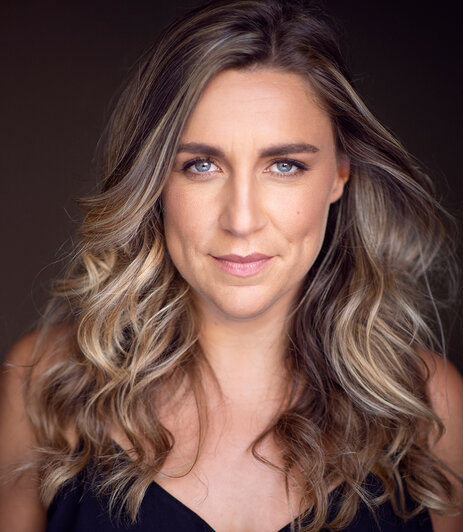The Grinning Man
A Versatile Choreographer, Movement Director, and Educator
Interview by Chris Duncan
Freya List is a critically acclaimed creative working across theatre, film, tv, company works and music. As well as being a versatile choreographer, movement director and educator, she is passionate about fostering community, and has created valuable platforms for dancers to interact and inspire both locally and abroad.
Freya, can you share with us what initially drew you to the project of ‘The Grinning Man’ and how your past experiences have influenced your approach to choreographing this production?
Freya List: I was initially drawn to this production because of the passion in which our Director Miranda Middleton had when she approached me about the show. Her excitement of bringing the show to Australia was palpable, particularly when paired with the support of Salty Theatre, The Alex Theatre and the original writers of The Grinning Man.
Once I started to explore the dark whimsical nature of the piece, I was hooked. My background of music theatre, contemporary and physical theatre will no doubt inform how I approach the production. 
Given the unique blend of dark humor, magic, and romance in ‘The Grinning Man,’ what have been some of the most challenging aspects of creating the choreography for such a multi-faceted narrative?
Freya List: Every show brings its unique challenges, and The Grinning Man is no different. Finding a movement language that aligns with the style of the show and every other element will be an evolving task.
Additionally, with multiple layers of realities within the script (show within a show, within a show… so many shows), choreographing transitions between these layers requires careful consideration and clarity. And as any local creative will say, and is often the case with any creative endeavor, time constraints add an extra layer of difficulty to find the detail we are all striving for.
How do you interpret the story of ‘The Grinning Man’ through your choreography, particularly in conveying the emotional depth and complexities of the characters?
Freya List: In interpreting the narrative of ‘The Grinning Man’ through choreography, particularly in conveying the emotional depth and complexities of the characters, the movement and physicality within the show must be intricately detailed to accentuate the themes explored, including the class divide and the experience of suppressing trauma over time. The production delves into the notion of being ‘othered’ while celebrating individual differences, reflected in moments when the cast executes the choreography with both precision and variation.
Could you describe your collaborative process with the director, Miranda Middleton, and how you both worked together to align the choreography with her vision of the show?
Freya List: Miranda (and the whole creative and design team) are extremely collaborative, which has made for a cohesive lead up to the rehearsal period. Miranda and I have not worked together before, so each step of the way we continue to find the communication style that ensures we can imagine what is going on in the other person’s head (tricky business). As the show is living in “a time that never was”, it is very important that we are building the same atmosphere and physical language. We hope that the movement blends seamlessly into the direction and you can’t tell where one stops and the other begins.
We both love exploring physicality with characters, and luckily we have a very playful cast willing to throw themselves into that way of working.
In a story where characters like Grinpayne and Dea have such distinct personal journeys, how do you use dance and movement to reflect their individual stories and development?
Freya List: In a narrative featuring characters such as Grinpayne and Dea, each undergoing profound personal transformations over 3 different life stages, incorporating dance and movement becomes a nuanced endeavour.
To authentically portray their jumps in the time, we need to use movement and physicality to transition between the characters’ distinct stages of life, necessitating seamless shifts in movement to signify temporal changes. Additionally, we are exploring ‘human puppetry,’ wherein another cast member embodies the younger versions of the characters, while the older iterations guide them through various styles of interaction and connection. Moreover, we confront the unique challenges posed by Grinpayne’s facial disfigurement and Dea’s blindness, crafting movement sequences that sensitively explore these aspects of their identities.
How does Sophie Woodward’s set and costume design influence your choreographic choices, especially considering the show’s German expressionism and carnivalesque themes?
Freya List: Sophie Woodward’s set and costume design was able to inspire much about how I developed the references for the movement within the show, especially with those German expressionism vibes and carnivalesque themes! Her use of German Expressionism shines through in both the design and has trickled the dance imagery, for example: creating shapes that only come together with people and limbs colliding in harmony. And let’s not forget about the projections – they add a fun twist by playing with size contrasts that interact with our dance routines. With the carnivalesque themes in play, our physicality has to stay on point to match the vibe. Plus, Sophie’s 3D printed wolf head prop, paired with grounded contemporary moves really bring out the animalistic side of our performance of the character Mojo.
The music in ‘The Grinning Man’ has been highly praised. How do you approach the task of translating such a powerful score into movement and dance?
Freya List: Having never heard any of the music before delving into this world, a big part of the process has been trying to understand how and when movement is called for. The score has been a joy to get to pull apart and learn about.
Our wonderful Music Director David Youings has been very collaborative with ensuring the relationship between the evolving score, and the movement are enhancing each other . We are constantly finding whether the movement is driving the music or vice versa.
What do you hope audiences will take away from the choreography in ‘The Grinning Man’, especially in terms of the emotional and thematic aspects of the show?
Freya List: Above all I hope the audience feels a sense of escapism. I hope the movement can help transport the audience further into the our Grinning Man world so that they can get whatever they need from the story.
With a cast that has diverse backgrounds in stage performance, how do you adapt your choreography to suit different skill levels while maintaining the integrity of the show’s vision?
Freya List: We’re fortunate to have a wonderfully diverse and talented cast! While their experience with choreography and stage performance varies (from first show to 40+ years in the industry),, movement in this show serves to deepen their characterisations. It’s crucial to collaborate closely with the cast, employing effective communication and processes to create movement that resonates.The choreographer’s role and the dance’s function within the show are ever-evolving!
After your experience with ‘The Grinning Man’, are there any other types of projects or genres you are particularly eager to explore in your future choreographic work?
Freya List: I am very much inspired by the boundless options and avenues to explore within physical theatre genre, and hope to continue exploring more of how this can cross into the music theatre world.
I also want to ensure that I am developing my skills to be able to deliver movement direction and choreography in a more accessible way. Working with this show, company and our consultants has inspired me to continue to grow my own creative practice and its relationship with accessibility.
Freya List Bio
Freya recently won the Green Room Award (Betty Pounder Award for Original Choreography) for her work on Cruel Intentions: The 90’s Musical (David Venn Enterprises) and Next To Normal (James Terry Collective). She was also nominated for the Betty Pounder Award for Excellence in Choreography for her work on Bright Star (Pursued by Bear). Other notable stage credits include the National tours of: Tick, Tick, Boom (StoreyBoard Entertainment) and Chess in Concert (StoreyBoard Entertainment), The Children (MTC/ STC), Next To Normal (James Terry Collective), A View From the Bridge (MTC), RENT (James Terry Collective), Parade (Soundworks), Kabaret Dietrich (Fringe Festival), Mystery of Edwin Drood, Sweet Charity, Little Women and Urinetown (VCA). As well as choreographing and directing her own full length dance works Half Full (Collaboration The Project) and Sondheim (Transit), she has been involved in developing the new works of WAGs (Workshop) and I Can Jump Puddles (Antipodes). Freya is currently in rehearsals for the Victorian Opera’s Candide, which will play at the Palais in early 2024.
Freya is the director of the international outreach program ‘Dancing Through India’ and the popular event series ‘Playing Field Series’ that highlights local musicians and dancers. Freya collaborates with many music artists through the creation of music videos, live shows, tours and movement coaching. Some of these artists include Hopium, Ben Abraham, Sex on Toast, Thelma Plum, Women of Soul Collective, Hayden Calnin, Woodes, Franco Gonzo, Chealsea Wilson and Braille Face. Freya is very excited to be part of bringing The Grinning Man to Australia for the first time.
You can read our The Grinning Man article here














